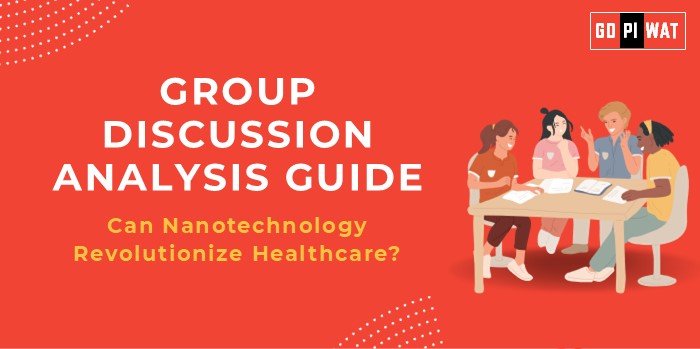📋 Group Discussion (GD) Analysis Guide: Can Nanotechnology Revolutionize Healthcare by Enabling Targeted Drug Delivery?
🌐 Introduction to the Topic
- 🔍 Opening Context: Nanotechnology, the manipulation of matter at the atomic and molecular scale, has become a cornerstone of scientific innovation. Its applications in healthcare, particularly targeted drug delivery, promise to address critical issues like inefficacy in treatments and systemic side effects.
- 💡 Background: Emerging in the late 20th century, nanotechnology has rapidly advanced, with its healthcare applications gaining prominence in the last decade. Breakthroughs include nanocarriers for chemotherapy and nanoparticles for precise imaging.
📊 Quick Facts and Key Statistics
🌍 Global Nanomedicine Market: Valued at $215 billion in 2023; projected CAGR of 12.5% by 2030.
🧪 Cancer Treatment Applications: Over 50 FDA-approved nanodrugs in oncology.
📈 Drug Delivery Efficiency: Nanocarriers improve bioavailability by 2-3 times compared to traditional drugs.
💰 Research Funding: $2 billion annually allocated globally to nanomedicine research.
🧪 Cancer Treatment Applications: Over 50 FDA-approved nanodrugs in oncology.
📈 Drug Delivery Efficiency: Nanocarriers improve bioavailability by 2-3 times compared to traditional drugs.
💰 Research Funding: $2 billion annually allocated globally to nanomedicine research.
🛠️ Stakeholders and Their Roles
- 🏢 Pharmaceutical Companies: Developing nanodrug delivery systems to enhance treatment efficacy.
- 🏥 Healthcare Providers: Integrating nanotechnology into diagnostics and treatment protocols.
- 🌍 Government Bodies: Funding research and regulating nanotechnology applications.
- 💊 Patients: Benefiting from improved outcomes and fewer side effects.
- 🎓 Academic Institutions: Conducting foundational research in nanotechnology.
🏆 Achievements and Challenges
✨ Achievements
- 🎯 Precision in Treatment: Nanoparticles can target specific cells, minimizing collateral damage.
- 💊 Reduced Drug Dosage: Nanocarriers enhance drug solubility, requiring smaller doses.
- 🔬 Improved Diagnostics: Nanoprobes provide high-resolution imaging for early disease detection.
⚠️ Challenges
- 🔄 Safety Concerns: Potential toxicity and long-term effects remain under study.
- ⚖️ Regulatory Barriers: Stringent approval processes slow down innovation.
- 💸 Cost: High R&D expenses limit accessibility.
🌎 Global Comparisons:
✅ Success: The U.S. leads in nanodrug approvals with initiatives like the Cancer Nanotechnology Plan.
❌ Challenges: Developing countries struggle with limited infrastructure for nanotech adoption.
✅ Success: The U.S. leads in nanodrug approvals with initiatives like the Cancer Nanotechnology Plan.
❌ Challenges: Developing countries struggle with limited infrastructure for nanotech adoption.
📄 Structured Arguments for Discussion
- 🟢 Supporting Stance: “Nanotechnology offers unprecedented precision in drug delivery, revolutionizing chronic disease management.”
- 🔴 Opposing Stance: “High costs and potential safety risks make nanotechnology unsustainable for widespread healthcare use.”
- ⚪ Balanced Perspective: “While nanotechnology shows promise in targeted drug delivery, its efficacy depends on addressing safety and accessibility issues.”
🗣️ Effective Discussion Approaches
- 📊 Opening Approaches:
- 🩺 Highlight breakthroughs, e.g., FDA-approved nanodrugs in oncology.
- 🔍 Compare nanotechnology’s potential with traditional drug delivery limitations.
- 🔄 Counter-Argument Handling:
- 🧪 Safety Concerns: Emphasize ongoing toxicity studies.
- 🤝 Cost Issues: Propose public-private partnerships for subsidized innovation.
🔍 Strategic Analysis of Strengths and Weaknesses
- 💪 Strengths: Precision, enhanced efficacy, diagnostic advancements.
- ⚠️ Weaknesses: High costs, regulatory hurdles, safety uncertainties.
- 🌟 Opportunities: Expanding R&D funding, partnerships in underserved regions.
- 🚨 Threats: Ethical dilemmas, unequal access in low-income nations.
🎓 Connecting with B-School Applications
- 🌟 Real-World Applications: Healthcare management, cost analysis, and innovation leadership.
- ❓ Sample Interview Questions:
- “How can nanotechnology influence healthcare policy?”
- “What role do public-private partnerships play in nanotech innovation?”
- 💡 Insights for B-School Students: Explore interdisciplinary projects in healthcare and technology management.


